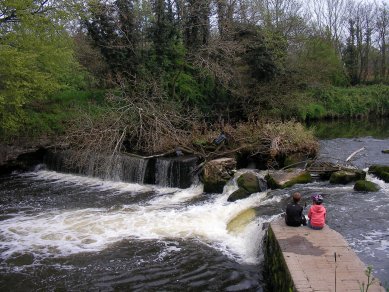
Eel Weir
The River Lagan catchment contains a small local stock of eels in its slow flowing lowland stretches and connected lakes. There are 13 lakes on the system which are accessible to eel, with a combined area of 77 hectares.
There is one eel weir on the River Lagan, which has been derelict since the 1950s. There is no data for historic fishing activity or catches at this weir, and there is no current fishing activity targeting eel.
The Lagan Canal
In 1756 the Commissioners of Inland Navigation for Ireland began work on the Lagan Navigation. Thomas Omer was appointed engineer in charge. In constructing the navigation, Omer opted to improve the existing river channel where suitable and to create a new 'cut' or canal where the natural water course followed large loops or meanders. Within a year a navigable channel existed from Belfast to Drum Bridge and by September 1763 this extended to Lisburn. The official opening took place among scenes of great enthusiasm and the first lighter to make the voyage was the 'Lord Hertford' carrying 45 tons of coal and timber.
Traffic on the canal increased throughout the 19th century but, eventually, competition from first rail then mechanised road transport caused a serious reduction in use. This understandable change was made more severe by the effects of the First and Second World Wars. After 1947 there was no canal traffic above Lisburn. The Lagan Navigation Company was dissolved in 1954 and the canal, between the Union Locks and Lough Neagh, was officially abandoned for all navigational purposes. The Lisburn to Stranmillis section remained open for a short time longer — It was closed in 1958. Control of the canal passed to the Government which, through the Department of Agriculture, carries out such works as are necessary for drainage, flood prevention and public safety.
Most canals were built before the development of mechanical propulsion. The only methods were therefore human or animal power, or the wind. Sailing vessels were once common on some rivers and canals in Great Britain, but on the Logan the principal method of traction was almost exclusively the horse — in later years some motor lighters were in use.
Each barge or lighter required a crew of at least two men — one to lead the horse and one to steer the barge. It seems remarkable that a single horse could pull, even if only at walking pace, a laden barge weighing up to 85 tons. Such was the ease of water transport. The horse could not, of course, walk directly in front of the barge as it would in front of a cart. Rather, the barge was steered to remain in mid-stream while the horse, walking along a path by the side of the canal, pulled the barge by a long tow rope. The path was known as the towing path, or towpath for short. And so it remains today, even though the barge horses completed the long haul many years ago.
The condition of the towpath deteriorated rapidly after the canal closed, although certain lengths remained popular as walks. When the Lagan Valley Regional Park was set up, in early 1967, restoration of the towpath was actively encouraged.
With over 500,000 recorded visits a year, the 12-mile Lagan Towpath connecting Belfast with Sprucefield (Lisburn) qualifies as the most popular public pathway in Northern Ireland.

The MournesRambler II Series
There are currently 24 caches in the MournesRambler II series which is designed to lure you away from the bright city lights along the Lagan Towpath:
The recommended mode of transport for this series is a bicycle, but it should also be quite feasible to complete it on foot. Have you found them all? If you have done them all one after the other please let us know (in your log entry) how long it took you so that others will know roughly how long it might take them.

The Eel Weir cache
There is more to this one than meets the eye :)
The cache itself is about the same length as a 35mm film canister, but it is smaller in diameter. It only contains a log, so please bring your own pen/pencil.
It should be quite easy to find the outer container, the real challenge is in retrieving the cache from it. Note, the clue should help you work out how to do it.
The camouflage for this cache is not very robust so please handle it with care. No screwdriver or brute force is required to reach the cache.
This area is frequented by muggles, so please be surreptitious and don't give away the location of the cache.